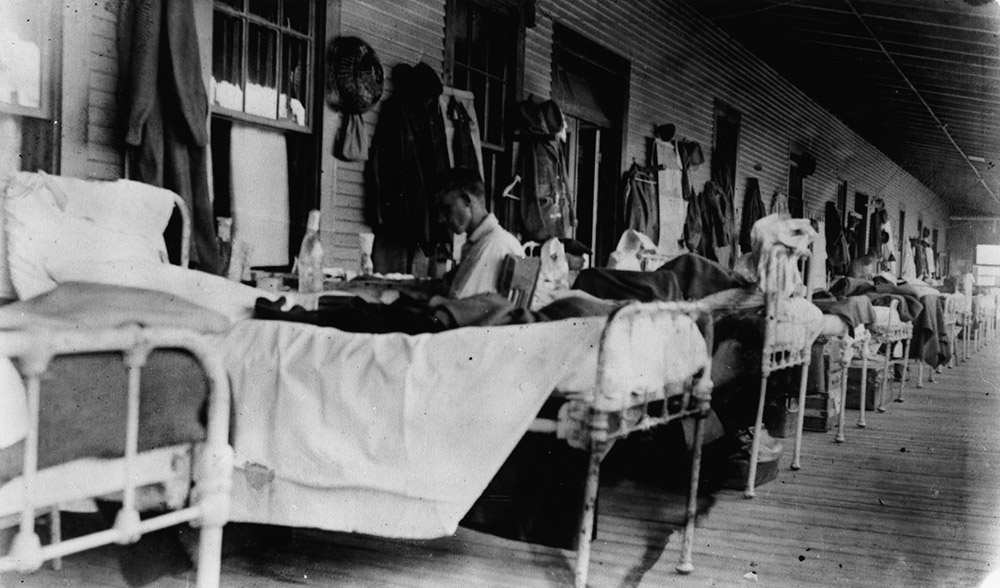New Mexico in a Time of Influenza

Fort Bayard Army Sanatorium for Tuberculosis Soldiers, where the first case of flu was reported in September 1918. Silver City Museum, image no. 3254.
Guest post by SAR scholar-in-residence Nancy Owen Lewis
On March 11, 2020, New Mexico reported its first three cases of COVID-19, which had already infected 1,215 other Americans. Having anticipated arrival of the virus, Governor Michelle Lujan Grisham declared a statewide public health emergency and took steps to address the emerging crisis.
When flu swept across the eastern seaboard in 1918, New Mexico denied that it could ever take hold here. The state had built an entire industry based on belief in the healing powers of its high and dry climate, which many thought conferred immunity from tuberculosis and other maladies. So why should New Mexicans fear the flu? That indeed was the message in an article titled “Spanish Influenza,” published in the Santa Fe New Mexican on September 28, 1918:
With our salubrious atmosphere and great distance from disease-infected ports, there is little likelihood that the Southwest will be visited by the epidemical malady.
Two weeks later, the 1918 flu claimed its first victim in Santa Fe. Within a few days, cases there skyrocketed to 175. Albuquerque physicians, who had previously claimed that the greatest danger from the flu was the panic it caused, changed their tune when cases began to multiply in their city. Doctors warned the public to “avoid crowds, wash your hands frequently, and cover your mouth and nose when you sneeze.” Sound familiar?

On October 18, Governor Washington Lindsey ordered the immediate closure of all courts, public schools, and churches. Public assemblies were forbidden. For the “First Time in Centuries, the City of the Holy Faith will say its Prayers at Home,” announced the Santa Fe New Mexican. As cases increased, St. Vincent Sanatorium in Santa Fe “threw open its portals and placed patients in every nook and corner.”
By November 2, an estimated 15,255 flu cases, with 1,055 related deaths, had been reported. But the final numbers remained unknown, for New Mexico lacked a vital records department. It was also the only state in the country without a department of public health. With fifty tuberculosis sanatoriums, it had a health system geared toward the out-of-state health seeker.
Two years earlier, the American Medical Association had published the results of a nationwide assessment of public health. Out of one thousand points, New Mexico was the only state to receive a score of zero. As one Chicago physician commented, “New Mexico sells health, but does not know whether she herself is healthy or not.” The state would soon find out.
Just prior to the fall outbreak, during the summer of 1918, several hundred New Mexico men, about to enter the military, had tested positive for tuberculosis. In an effort to find treatment for them, Governor Lindsey contacted sanatoriums throughout the state, but the beds were full.
Distressed by the lack of health care for local residents, Governor Lindsey appealed to US Surgeon General Rupert Blue, who sent Dr. John W. Kerr from the US Public Health Service to conduct a statewide survey. He arrived on September 16, 1918. Five days later, the first flu case was reported at the Army Sanatorium at Fort Bayard, northeast of Silver City, New Mexico. The flu also swept through the US Public Health Service Sanatorium at Fort Stanton, west of Lincoln, New Mexico, infecting nearly half of its three hundred patients. Dr. Kerr took a break from his survey to coordinate relief efforts. By December 2, the epidemic had waned and quarantines were lifted. Kerr resumed his survey, which presented a sobering picture of health in New Mexico, and he urged the state to establish a public health department. His report formed the basis of a bill creating a Department of Health, which Governor Octaviano Larrazolo signed into law on March 19, 1919.
As for today’s coronavirus outbreak, I am thankful we have a public health department. Like the 1918 flu, this pandemic too shall pass.

Chasing the cure at Southwestern Presbyterian Sanatorium, Albuquerque. New Mexico’s sanatorium industry catered to the out-of-state health seeker. Photograph by Ward Hicks, Albuquerque Museum, image no. PA 1982.181.435.

Nancy Owen Lewis, SAR scholar-in-residence, is the author of Chasing the Cure in New Mexico: Tuberculosis and the Quest for Health (Museum of New Mexico Press, 2016).
This piece appears in the spring/summer 2020 issue of SAR Now, a bi-annual print newsletter sent to all SAR members. Become an SAR member to receive the newsletter straight to your mailbox and enjoy other benefits of membership.